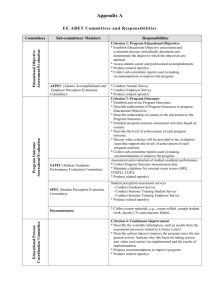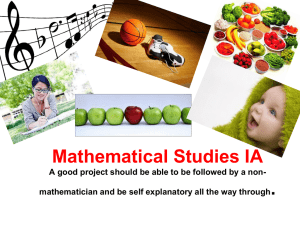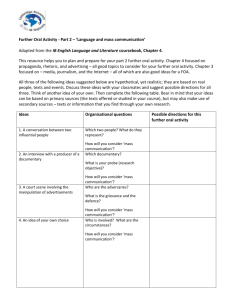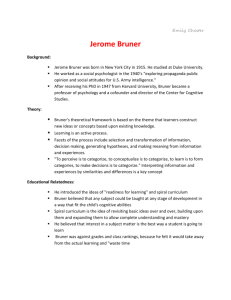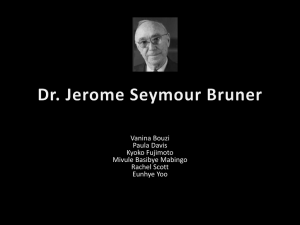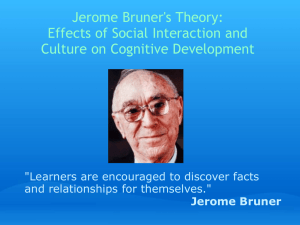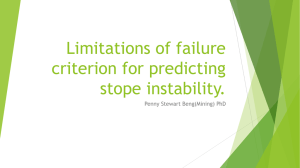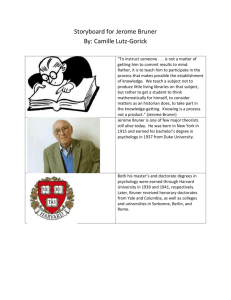Methods of Teaching of various School Subjects
advertisement
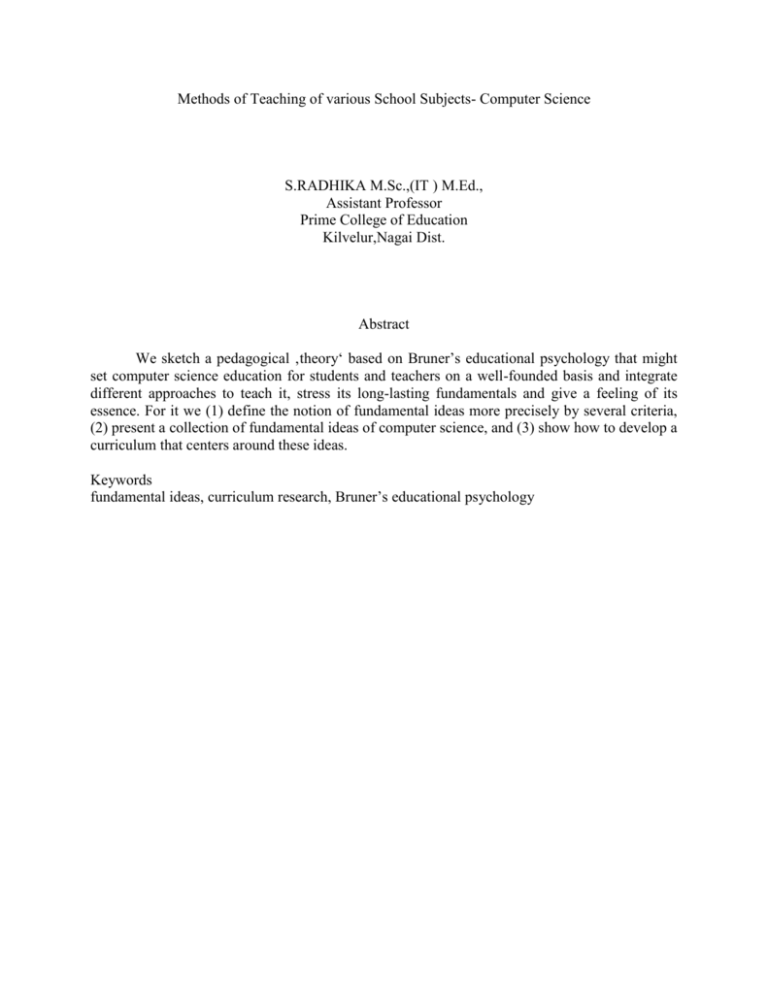
Methods of Teaching of various School Subjects- Computer Science S.RADHIKA M.Sc.,(IT ) M.Ed., Assistant Professor Prime College of Education Kilvelur,Nagai Dist. Abstract We sketch a pedagogical ‚theory‘ based on Bruner’s educational psychology that might set computer science education for students and teachers on a well-founded basis and integrate different approaches to teach it, stress its long-lasting fundamentals and give a feeling of its essence. For it we (1) define the notion of fundamental ideas more precisely by several criteria, (2) present a collection of fundamental ideas of computer science, and (3) show how to develop a curriculum that centers around these ideas. Keywords fundamental ideas, curriculum research, Bruner’s educational psychology Methods of Teaching of various School Subjects- Computer Science INTRODUCTION Although computer science is a regular subject in school for a long time, there is still more and more discussion on how to teach computer science and what to teach: Should computer science education be oriented more towards its applications or more towards its fundamentals or more towards its social effects? How can we improve computer science education with teachers who have not passed a full university education in that field? How can we cope with the rapid developments of computer science, both with respect to curriculum development and continuing education? Just to explain the last point we see that after more than 40 years computer science is still developing dynamically .This competency is possibly achieved best if students and teachers are given a sketch of the fundamental ideas, principles, methods and ways of thinking of computer science, instead of trying to teach them an incoherent set of recent technology-driven developments as is often done by in-service teacher education programs. Only the fundamentals seem to remain valid in the long term and enable students and teachers to acquire new concepts successfully during their professional career, since these new concepts will then often appear to be just further developments or variants of ideas already familiar and so are comprehensible to students and teachers more easily. FUNDAMENTAL IDEAS AS AN EDUCATIONAL PRINCIPLE Whitehead (1929) proposed to deal in school with „few general ideas of far-reaching importance“, since the students are „bewildered by a multiplicity of detail, without apparent relevance either to great ideas or to ordinary thoughts“. The same situation we often have - so are the author’s experiences - if teachers have passed a quick in-service education program in different „modern“ subjects of computer science that enables them neither to establish a stable cognitive structure integrating all these subjects nor to teach computer science to their students in a suitable manner. Bruner (1960) formulated the teaching principle that lessons should be based on the structure of science which is defined by so-called fundamental ideas. He justified his approach as follows: Learning is mainly for preparing us to master our future life more successfully. In order to cope with changes occurring later in private life, economy and society students must be able to transfer knowledge acquired earlier to new situations. Of particular interest here is the nonspecific transfer which relates to long-term (often life-long) effects: We should teach on a metalevel fundamental notions, principles and ways of thinking (so-called fundamental ideas) and may hope that students are able to use these abstract solution schemas in modified („transfered“) form for any (even absolutely new) problems they may face in their later lives. Nonspecific transfer should dominate the entire educational process of schools providing general education: Permanent creation, extension and consolidation of knowledge in form of fundamental ideas. Therefore - and now we return to Bruner’s request - all curricula and teaching methods in computer science classes as well as inservice or preservice education programs for teachers should stress the fundamental ideas of each topic As applied to computer science we define the notion as follows: A fundamental idea of computer science is a schema for thinking, acting, describing or explaining which satisfies four criteria: The Horizontal Criterion. A fundamental idea is applicable or observable in multiple ways and in different areas of computer science and organizes and integrates a wealth of phenomena. We call this property the Horizontal Criterion, since the idea may be considered as a horizontal line intersecting a large number of fields where it applies. The Vertical Criterion. A fundamental idea may be taught on every intellectual level. Bruner (1960) said that „any subject can be taught effectively in some intellectually honest form to any child at any stage of development“. This suggests that a fundamental idea organizes the topics of a field also in a vertical dimension: An idea can be taught on the primary school level as well as on the university level. Presentations differ only by level of detail and formalization. Thus, an idea can serve as a guideline for lessons on every level of the entire educational process and ideas can be revisited periodically in greater depth and complexity (so-called spiral principle, see also below). The Criterion of Time. A fundamental idea can be clearly observed in the historical development of computer science and will be relevant in the long run.This aspect is important for two reasons. First, it gives a clue as to how to find fundamental ideas:Scientific notions, concepts or structures of computer science that have a definite historical background are more likely fundamental ideas than are recent developments. Second, lessons basedon fundamental ideas will not become antiquated as quickly as conventional lessons - a majoradvantage in teaching computer science given its dynamic evolution. The Criterion of Sense. A fundamental idea also has meaning in everyday life and is related to ordinary language and thinking - its context being pretheoretical and unscientific. Only a precise definition turns an idea „with sense“ into an exact notion „without sense“. For example, consider „reversibility“ as an idea „with sense“ and „inverse function“ as a purely mathematical formalization of it „without sense“. While we can see examples of reversibility in many everyday situations - do vs. undo - the term „inverse function“ has no everyday meaning. From the pedagogical point of view this criterion is closely linked to the Vertical Criterion. Wheneverwe have to teach a fundamental idea on a low intellectual level, i.e. we have to give students a first vague impression of the idea, we may begin with those situations in everyday life where a fundamental idea becomes apparent. FUNDAMENTAL IDEAS OF COMPUTER SCIENCE By now fundamental ideas have been proposed mainly for mathematics (e.g. Halmos (1981)) and some of its branches (e.g. Heitele (1975)), but there are very few comments on how these ideas have been worked out. We have tried to determine fundamental ideas by abstracting from the contents of computer science to its ideas in three steps: (1) Analysis of the concrete activities of computer science and their relationships and analogies. Since a central purpose of computer science is to investigate the software development process in its broadest sense and to provide methods for it, it seemed reasonable to first analyze for fundamental ideas the concrete activities during this process and then to establish relationships and analogies to the field of computer science in general; (2) Revision and improvement of the results obtained in step 1 by checking whether each idea satisfies the four criteria for fundamental ideas; (3) Structuring the collection of ideas according to their relevance in computer science. Due to space limitations we only present the final results. The fundamental ideas that dominate all stages of software development as well as all activities in computer science - algorithmization, , of which gives - on further analysis – a wealth of other fundamental ideas (below written in italics). Algorithmization By algorithmization we denote the entire process of designing, implementing and running an algorithm. The strong relevance of algorithmization within computer science, as required by the Horizontal Criterion, seems obvious. A careful analysis of the activities when developing algorihms gives a wealth of other fundamental ideas which may be assigned to four large domains - design, programming, execution, evaluation: During design of an algorihm one often uses powerful paradigms such as divide and conquer, backtracking etc. Afterwards this design is carried over into a program using several basic ideas to describe data and control structures, e.g. concatenation, repetition, recursion of commands and data. The finished program is executed on one or more processors. A fundamental idea here is the notion of process, i.e. the separation of description and execution of an algorithm. The last group of ideas deals with assessing the quality of algorithms. The two main criteria are correctness and complexity each related to several corresponding ideas. Computer science education of students and teachers. So far this approach seems to have the following advantages: • A subject is more comprehensible if students and teachers grasp its fundamental principles. • Fundamental ideas condense information by organizing uncoherent details into a linking structure which will be kept in mind for a longer time. Details can be reconstructed from this structure more easily. • Fundamental ideas enable teachers (1) to evaluate all the current buzz-words and modern themes of computer science according to school relevance, (2) to find the „beef“, if any, in these subjects, and (3) to teach these subjects to their students pedagogically sound. • Fundamental ideas reduce the lag between current research findings and what is taught in schools (Vertical Criterion). This expresses the conviction of Bruner (1960) that „intellectual activity is the same anywhere, whether the person is a third grader or a research scientist.“ • While fundamental ideas remain modern even in the long term (Criterion of Time), details become antiquated very early. CONCLUSIONS computer science education based on fundamental ideas can free itself from the innovative pressure of science without the content getting out-of-date. At the present time, computer science has no „philosophy of computer science“ while established sciences have evolved such philosophies. A collection of fundamental ideas may serve as a first approach in this direction, may help to determine the essence of computer science and to dissociate it from other sciences, and may provide a useful way for thinking about teaching computer science in the classroom. REFERENCES Bruner, J.S. (1960) The process of education. Harvard University Press, Cambridge MA. Bruner, J.S. (1966) Toward a theory of instruction. Harvard University Press, Cambridge MA. Halmos, P.R. (1981) Does mathematics have elements? The Mathematical Intelligencer, 3, 147153. Heitele, D. (1975) An epistemological view on fundamental stochastic ideas. Educational Studies in Mathematics, 6, 187-205. Whitehead, A.N. (1929) The Aims of Education, MacMillan.



